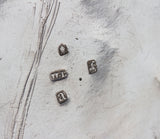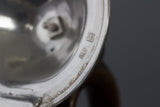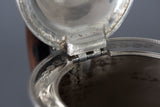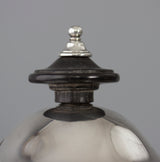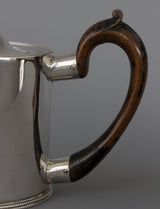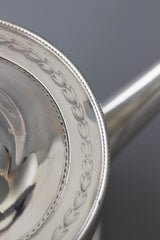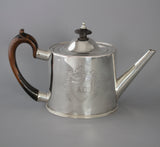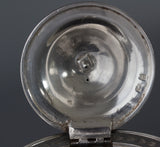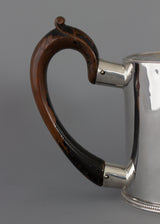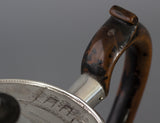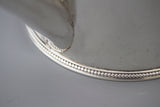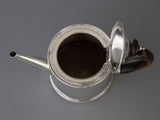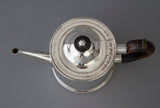A very fine George III Silver Drum Teapot, London 1776 by Walter Brind
A rare early George III silver drum form teapot. Of plain circular body with beaded borders, with a tulip pattern engraved around the top. The plain raised lid is topped with an ebonised wooden finial capped with a silver mount. A tapering spout and c-scroll wood handle with scroll thumbpiece. Floral cartouche, with initials engraved to one side. (see pictures)
Hallmarked underneath for London 1776 and to the lid with the lion passant, both stamped with the makers mark W.B in a shaped punch for Walter Brind.
This teapot is in very fine condition with a wonderful lustre and patina. No splits or holes, some very minor bruising to the body. An old repair to the handle & the hinge is in good order and it stands true on a flat surface. A very rare example of a teapot which was only fashionable for a short period of time and thus very scarce.
Length (handle to spout): 23.5cm or 9¼“
Diameter: 11cm or 5½“
Height: 13.5cm or 5½“
Weight (including handle): 458g or 16.15oz
Walter Brind b.1722, d.1796
Walter Brind was apprenticed to John Raynes 7th October 1736 and turned over to his brother Henry in July 1742. Free on 8th November 1743. His first mark was entered as a large-worker 1749 and the address given was in Foster Lane, where Heal records him until 1796. He was a prolific maker of very good holloware who had a career spanning nearly 50 years and his four sons followed him into the goldsmith profession. He died between 9th May 1796 (when his will was made - presumably on his deathbed) and sometime before 26th July 1796 (when it was proved).
Silver Teapots
The first recorded silver teapot made in England was in around 1670. Made as a gift for the East India Company from George, Lord Berkley. The teapot was inscribed “This silver tea Pott was presented to the committee of the East India Company by the Right Hono George Ld Berkley of Berkley Castle. A member of that Honourable and worthy Society and A true hearty Lover of them. 1670.”
This teapot was typical of the period and took the form similar in shape to the chocolate or coffee pot. However, due to the very high cost of tea at this time, teapots were very small, and other pots made in the same period were more melon shaped, taking their form from the Chinese earthenware pots, which were increasing in popularity throughout Europe. It was found that silver was the perfect material for brewing tea in because of its heat properties and its durable nature.
The teapot design evolved rapidly through the eighteenth century. In the early 1700s, the spouts were often modelled in the form of a birds beak, the lid hinged and the handle of polished wood, ebony or leather coated plain wood. Patterns changed from compressed octagonal form, and from 1725-1750, rounded bullet-shaped teapots were popular. The French Rococo style also had a big influence leading to more elaborate decoration in the form of flowers, swirls and chinoiserie designs. By 1776 the Sheraton style rounded drum-shape prevailed, succeeded by the Hepplewhite oval-form style seen from 1789 to 1800. Both of these designs feature straight spouts, and a subtle change in construction.
However, the real changing point that prompted big changes in design and manufacture was when William Pit the Younger slashed the tea levy in 1784. Before this, tea had been exclusively for the upper classes as it was exceedingly expensive and only a very small proportion of the population could afford it. This opened up tea drinking to the masses, and led to the intricate and varied designs we see from the nineteenth century right through to the modern day - prime examples being produced by Paul Storr, Benjamin Smith through to Christopher Dresser.






